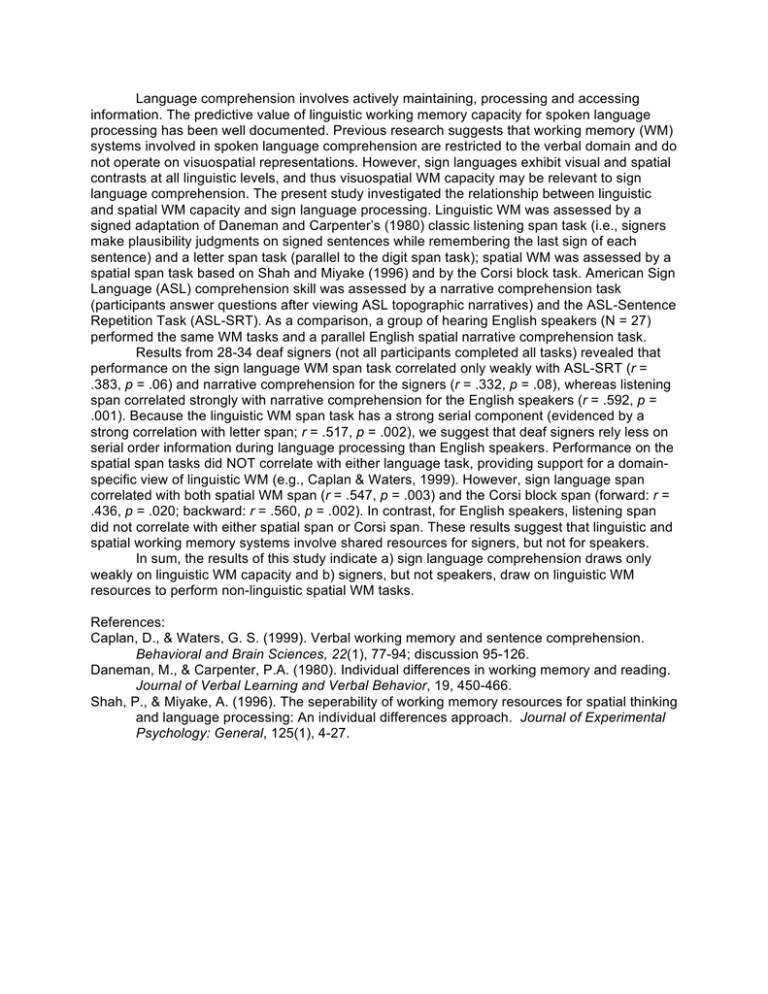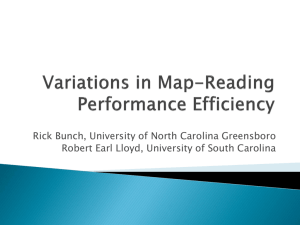Language comprehension involves actively maintaining, processing and accessing
advertisement

Language comprehension involves actively maintaining, processing and accessing information. The predictive value of linguistic working memory capacity for spoken language processing has been well documented. Previous research suggests that working memory (WM) systems involved in spoken language comprehension are restricted to the verbal domain and do not operate on visuospatial representations. However, sign languages exhibit visual and spatial contrasts at all linguistic levels, and thus visuospatial WM capacity may be relevant to sign language comprehension. The present study investigated the relationship between linguistic and spatial WM capacity and sign language processing. Linguistic WM was assessed by a signed adaptation of Daneman and Carpenter’s (1980) classic listening span task (i.e., signers make plausibility judgments on signed sentences while remembering the last sign of each sentence) and a letter span task (parallel to the digit span task); spatial WM was assessed by a spatial span task based on Shah and Miyake (1996) and by the Corsi block task. American Sign Language (ASL) comprehension skill was assessed by a narrative comprehension task (participants answer questions after viewing ASL topographic narratives) and the ASL-Sentence Repetition Task (ASL-SRT). As a comparison, a group of hearing English speakers (N = 27) performed the same WM tasks and a parallel English spatial narrative comprehension task. Results from 28-34 deaf signers (not all participants completed all tasks) revealed that performance on the sign language WM span task correlated only weakly with ASL-SRT (r = .383, p = .06) and narrative comprehension for the signers (r = .332, p = .08), whereas listening span correlated strongly with narrative comprehension for the English speakers (r = .592, p = .001). Because the linguistic WM span task has a strong serial component (evidenced by a strong correlation with letter span; r = .517, p = .002), we suggest that deaf signers rely less on serial order information during language processing than English speakers. Performance on the spatial span tasks did NOT correlate with either language task, providing support for a domainspecific view of linguistic WM (e.g., Caplan & Waters, 1999). However, sign language span correlated with both spatial WM span (r = .547, p = .003) and the Corsi block span (forward: r = .436, p = .020; backward: r = .560, p = .002). In contrast, for English speakers, listening span did not correlate with either spatial span or Corsi span. These results suggest that linguistic and spatial working memory systems involve shared resources for signers, but not for speakers. In sum, the results of this study indicate a) sign language comprehension draws only weakly on linguistic WM capacity and b) signers, but not speakers, draw on linguistic WM resources to perform non-linguistic spatial WM tasks. References: Caplan, D., & Waters, G. S. (1999). Verbal working memory and sentence comprehension. Behavioral and Brain Sciences, 22(1), 77-94; discussion 95-126. Daneman, M., & Carpenter, P.A. (1980). Individual differences in working memory and reading. Journal of Verbal Learning and Verbal Behavior, 19, 450-466. Shah, P., & Miyake, A. (1996). The seperability of working memory resources for spatial thinking and language processing: An individual differences approach. Journal of Experimental Psychology: General, 125(1), 4-27.



